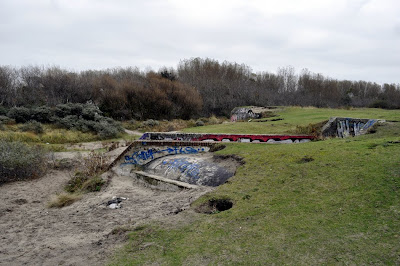Last month I visited a highway overpass...
Ooms Avenhorn BV is a Dutch construction firm specializing in large-scale infrastructure and roads. Over the past decade they’ve developed a method of harnessing the heat energy latent in sun-warmed asphalt to do work. Heat generated by sun radiating on the black asphalt in summer is pulled from the road mass by a liquid flowing through embedded tubing and stored deep in the ground with a geothermal loop. In winter, that same heat is cycled back up to the surface for use. In several projects by Ooms Avenhorn, the stored heat is used to augment the geothermal heat exchange systems of adjacent office and apartment buildings. Conversely, when the road surface dips below ground temperature, heat from the ground is cycled through the system to keep the road surface above the freezing point. The resultant temperature of the fluid in the system is lower than ground temperature – this cold is then “stored” in the ground in aquifers, it’s thermal mass chilled below the temperature of the surrounding earth. In summer, the cold temperatures improve the efficiency of building air conditioning. To accomplish these dual roles, a “cold” well and a “hot” well are used– separated from each other by about 100 meters. Imagine a radiating node of warm land mass and an energy void of cold land mass 100 meters apart deep below ground level – over time, the zones would revert to a median temperature, but at 100 meters below the surface, they are well insulated.
Benefits also accrue to the road itself. The road surface that is kept above freezing will prevent icy conditions during precipitation, improving driver safety, and will prevent freeze-thaw cycles that destroy asphalt road surfaces. With no salt on the roads in winter, surrounding wetland ecologies and immediate environments are spared degradation. Savings are also realized from the longer lifespan of roads that employ the technology – in summer the asphalt doesn’t melt and deform under heavy loads and in winter it won’t crack in freeze-thaw cycles. The way the system is a kind of ‘consumption smoothing,’ to borrow a term from economics. Just as rational consumers balance their saving and expending over a lifetime to maintain a good standard of living, the energy consumption of a built environment is smoothed out between the temperature fluctuation of seasons to attain higher efficiencies of heat allocation. It’s a neat trick to use the heat of a summer day to warm an apartment in mid-winter – better still to cool off in July with the borrowed chill of a January pre-dawn - all by harnessing the latent potential of our own built environment sitting passively under the sun.
I recently visited Ooms Avenhorn BV’s largest installation, a 10,000 square meter section of highway overpass (the Vondelingenviaduct te Hoogvliet) in the industrial section of Rotterdam adjacent to part of Royal Dutch Shell’s massive petro-chemical complex. The project was installed in 2003. In this case, the installation exclusively serves the road itself, preventing thermal expansion in summer and icy road conditions in winter. I can imagine the next generation of projects engaging their surrounding buildings in a multi-property thermal energy network, a public resource adding a new dimension to the idea of commonwealth.





 above image found at: http://knowledge.allianz.com/en/globalissues/climate_change/climate_solutions/heat_pump_street.html
above image found at: http://knowledge.allianz.com/en/globalissues/climate_change/climate_solutions/heat_pump_street.html
 above image found at: http://www.spec-net.com.au/press/0209/vsc_110209.htm
above image found at: http://www.spec-net.com.au/press/0209/vsc_110209.htm
Not every road surface could use this technology – the cost would not justify the expense. A large array of flat plate or vacuum solar collectors, when integrated with a geothermal storage system could dramatically outperform a similarly scaled asphalt-based project. The technology is probably only useful for application in climates where summer and winter temperatures are divergent. But in the appropriate climate, in high-density situations with lots of demand for heating and cooling and adjacent to high traffic areas, the road energy system shows a great deal of promise. It is the hybrid function of the road energy system and the vast potential of the underutilized surface out there that makes the road system attractive. In an urban context, we need to plan for the day when the multitude of sustainable energy strategies begin to crowd each other out – they tend to be space intensive and many are sun loving. We’ll have to be creative and resourceful about the use of formerly passive elements of our immediate constructed environment. By imbedding and interlaying performative technologies within familiar settings, we’ll activate our surroundings as a built ecology. The goals are to facilitate efficient resource use and communication, enhance the experience of architecture, and improve quality of life. This has been a focus of designers in theory for some time – how to make surfaces performative, networked, smart, or intelligent. Ooms Avenhorn BV’s road systems are an example of some tangible engineering that designers can work with and explore further.
First applications will be building types that have high heating and cooling demand and large parking lots: factories and big box retail, office parks and malls. Further afield, urban plazas and neighborhood could use the technology. As energy prices rise and a conservation ethic becomes more imperative, life cycle cost analysis of these projects will one-day justify the costs of installation. Claims of improved efficiency resulting from the project were hard to pin down in literature I read, but a few sources mention a 20-30% reduction in energy costs for buildings that link up to the system, and a 50% reduction in Carbon emissions as a result.
Another source states that the asphalt system yields half as much power per square meter per year as a photovoltaic panel at 1/12th the cost. These are real gains, and suggest that the technology warrants further exploration. It’s interesting to think about the possibilities. Who knows - one hundred years from now and beyond, a system deployed widely enough as an intelligent network could even mitigate the heat island effect of cities.















